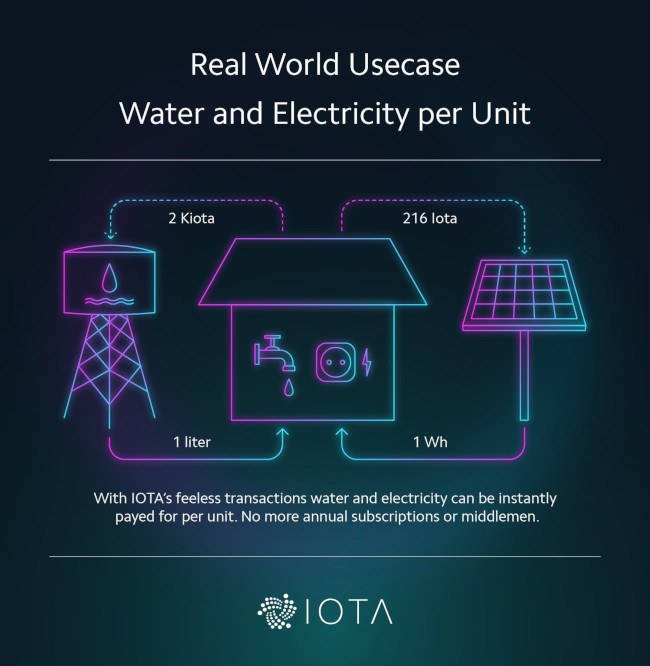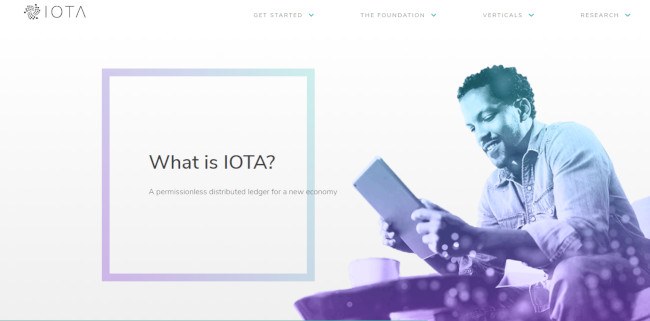Some cryptocurrencies are tackling mundane problems, but others are revolutionary, and are taking on the bleeding edge of technological developments. IOTA is one such project, designed specifically for the Internet of Things. It is unique and there’s no other project out there quite like it. If IOTA is successful it could very well become the transactional fuel that keeps millions on internet connected and enabled devices communicating and functioning properly.
One way to think of the direction IOTA is taking is to think of the evolution in supermarket checkout lines. The addition of self-checkout may be annoying to some people, but there’s no denying that it has made the check-out process more efficient, and more profitable for the supermarket versus hiring cashiers. Take this to the next level and imagine you could scan items as you moved through the supermarket, and that there would be robots which then assembled your order and it was delivered right to your car after you went through the checkout process.
These types of transactions and much more will be possible with the Internet of Things, and IOTA is working on a solution that will connect all the nodes of myriads of networks to allow automated responses to occur behind the scenes.
What is IOTA?
IOTA is a cryptocurrency, but its also a means for issuing micropayments instantly and without any network fees attached to the payments. This makes it significantly different from other coins, and the lack of network fees makes it possible for transactions of $0.0001 or less to take place if needed. This is a breakthrough because it guarantees even the smallest network tasks can be accomplished on a network. With more and more devices joining network connectivity this functionality will become increasingly important, and will allow us to control anything that’s connected to the broad network.
IOTA began with an ICO back in 2015 which collected just 1,337 Bitcoins. Compared to more recent ICOs this seems a small amount indeed, but we have to remember that ICOs were uncommon in 2015. Still, by June 2017 IOTA (or rather MIOTA) was added to the world’s largest cryptocurrency exchange of the time – Bitfinex. Subsequently in the fall of 2017 IOTA began partnering with major corporations, and deals were concluded with the likes of Volkswagen, Samsung, Microsoft, Deutsche Telecom, and Fujitsu. IOTA was on its way to mainstream adoption.
IOTA Review: How IOTA Works?
While IOTA is a cryptocurrency it is very different from other blockchain projects, because it isn’t a blockchain at all. Instead it uses something it calls The Tangle, which is a Directed Acylic Graph (DAG). In blockchains every transaction is verified by the network participants and then recorded in blocks. IOTA’s Tangle has no blocks. Instead, transactional information is verified by previous transactions. This works by having every new transaction (call this transaction A) confirming the two older transactions (transactions B and C). Verification can also happen indirectly – for instance transaction D, which confirmed A and conditional Z. But it indirectly it also confirmed B and C.
A system like this creates a huge web of verifications, which helps protect the network from the double spending problem and also provides increased efficiency. With the IOTA Tangle the more transactions that occur on the network the more secure and faster the network becomes.
IOTA also differs from most blockchains because mining is impossible. All of the tokens that will ever exist were immediately released at the genesis. This is roughly 2.8 trillion coins, but is specifically described in JavaScript as the value MAX_SAFE_INTEGER. In trading on exchanges the larger MIOTA is used, which means 1 million IOTA.
The Internet of Things and IOTA
The prospects for IOTAs success are directly tied to the prospect of success for the larger Internet of Things – or a global network where most physical objects are internet enabled and can interact with each other through on-board technologies. Currently we have just small pockets of network enabled devices, but the path towards a full-fledged global network continues to grow.
For example, consider the modern apartment which can now use such things as NEST technology to automatically regulate the heating, electricity usage and lighting, among other things. Because these single apartments can be united in larger apartment buildings, which themselves create towns and cities, and cities will unite in the global network.
With IOTA nearly every function or process within an Internet of Things ecosystem can be tied together. This is accomplished by configuring the transactional chains in such a way that micro-transactions can occur in massive quantities and without cost. The platform has also been developed so that uninterrupted internet connectivity is not a requirement to participate in the network. For some devices a connection once a year might be sufficient, saving on electricity and bandwidth.

IOTA Review: Advantages and Disadvantages
As a cryptocurrency there are definite advantages to IOTA. The obvious top advantage is the lack of network fees or commissions which enable micro-transactions and a high transactional speed. The Tangle allows for all of these advantages. However, because the Internet of Things is still developing its difficult to gauge the future success of IOTA. It’s like when the internet was released to the general public. Many people saw there was a huge potential, but without any tangible examples it was difficult to see how it would eventually succeed.
As long as the IoT continues developing, IOTA will see increased usage. It’s also encouraging to see the active development of the project, and the partnerships with some of the largest global companies. IOTA has a jump on other potential uses of the IoT, and this first mover advantage is surely an advantage. It puts additional weight behind the project, and should help keep the value of the coins increasing. After all, the IOTA coins must act as the fuel for the rapidly developing platform.
Security has been brought up as one of the disadvantages of IOTA, with some fearing a 51% attack could be possible before the network has grown large enough to combat such an attack simply by its expanse. IOTA has tackled the problem with something it calls The Coordinator, a special node which digitally signs transactions it issues in the Tangle, as well as their location. The Coordinator issues transactions by the same method as any other node, the only difference being that it also signs the location so that they cannot be subsequently reattached to a different location. While detractors say that this Coordinator makes IOTA centralized, it is planned to be removed once network transactions reach a level that would make a 51% attack impossible.
IOTA Review: Conclusion
It took IOTA roughly 2 years from its ICO to debut in crpytocurrency exchanges, but only 6 months longer for it to capture roughly 3% of the market capitalization of the entire cryptocurrency markets. That has dropped to roughly 1% of the market as of July 2018, but IOTA remains in the top ten of all cryptocurrencies. MIOTA currently trades at just $1.11, which might be a bargain if the project can realize its eventual goal. Just several months ago there were predictions of MIOTA hitting $150 by the end of 2018. Of course the entire cryptocurrency markets have been in a bear downtrend for most of 2018, which has hurt crypto across the board. Let’s not forget too that the highest price for MIOTA has been $5.23, so any projection as high as $150 is quite optimistic.
Optimistic yes, but there are those who don’t believe it’s out of the realm of possibility. And it’s true that if the Internet of Things continues to expand and grow IOTA could have a huge impact. The project has already built a strong foundation, and continues making positive strides, so this might be a case where it just needs enough time to mature properly.
A site is already under development that would allow for the monetization of data generation, where companies could transact with their customers. The project is also working on private transactions, a new method of creating instant transactions, and the use of IOTA as a payment instrument on additional processing platforms.
Patience may be the key with IOTA, and investors may need to wait as much for the development of the Internet of Things as they do for the development of IOTA.
